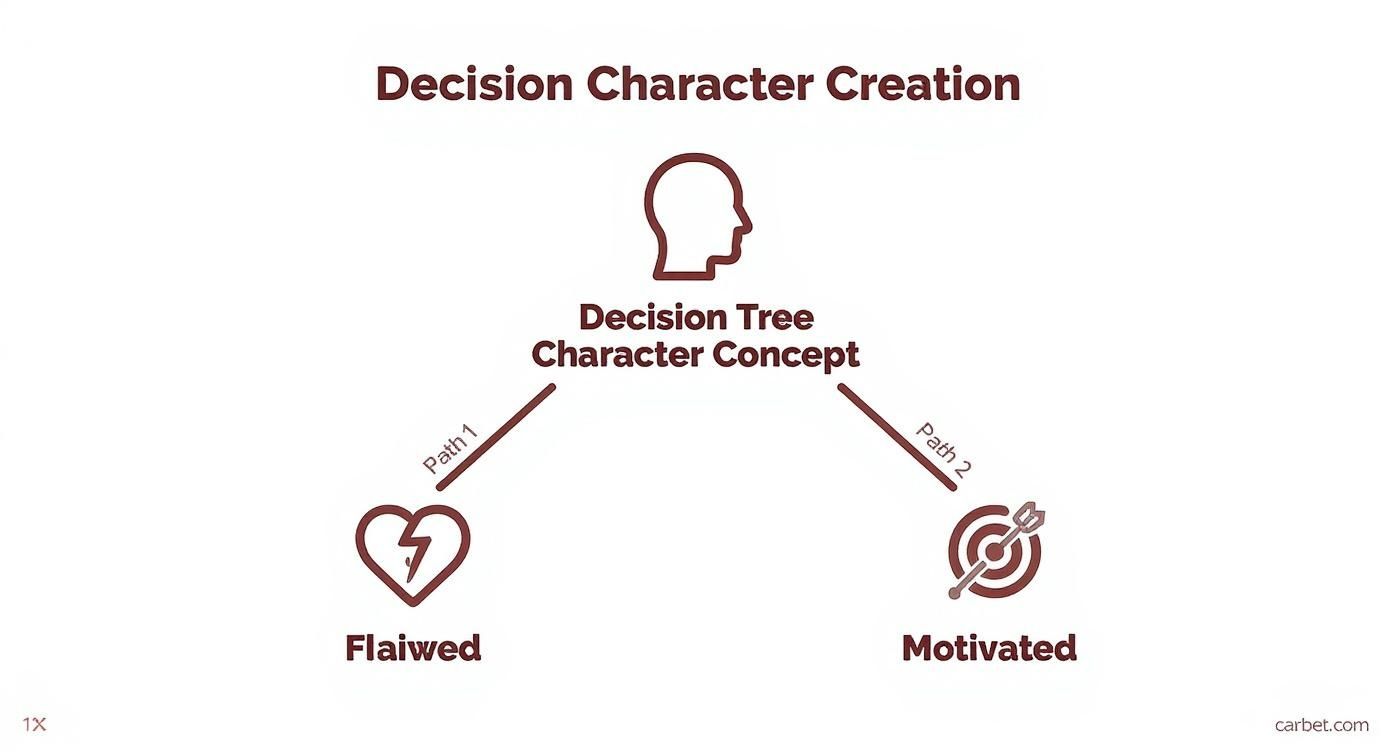Create Your Own AI Girlfriend 😈
Chat with AI Luvr's today or make your own! Receive images, audio messages, and much more! 🔥
4.5 stars

Adult interactive fiction isn't just a niche anymore; it's a booming space where readers don't just follow a story—they drive it. We've moved way beyond the classic "choose your own adventure" model. Today, this genre dives deep into complex themes, explores the messy reality of nuanced relationships, and presents mature scenarios that genuinely connect with an adult mindset.
Building Your Narrative Foundation

Before you even think about writing the first choice, you need to lay the groundwork. Who are you writing for, and what kind of world are you inviting them into? Crafting a powerful experience for adults means ditching the generic plots and embracing the kind of complexity mature readers are hungry for. This is less about just throwing in "adult content" and more about building a world where choices have real consequences and the characters feel like people you could actually know.
And make no mistake, there's a huge audience for this. The global adult visual novel market, just one slice of this pie, is on track to hit $1.2 billion by 2025. That kind of growth sends a clear signal: people want stories that speak to them on an adult level. You can dig deeper into these market trends and their drivers to see just how big the opportunity is.
Defining Your Audience and Tone
So, who’s your ideal reader? Are they a fan of gritty neo-noir mysteries, eager to unravel a conspiracy? Maybe they're looking for a tangled political drama or an intensely personal romance. Nailing this down is the single most important decision you'll make, as it dictates everything that follows.
- Embrace Moral Ambiguity: Forget clear-cut heroes and villains. Adult stories thrive in the gray areas, pushing players to make tough calls with no obvious "right" answer.
- Use Sophisticated Humor: Step away from the slapstick. Adult humor can be wickedly satirical, bone-dry, or darkly ironic—reflecting a more seasoned perspective on the world.
- Explore Emotional Depth: Tackle the big stuff: loss, ambition, betrayal, redemption. Adult readers are drawn to characters who feel like they've lived a life, made mistakes, and are carrying some real emotional weight.
Think about it this way: a story about a detective might not be about simply catching the killer. Instead, the core conflict could be about whether that detective is willing to shatter their own moral code to see justice done. That's the kind of shift that makes a narrative feel truly adult.
To get you started, here’s a quick breakdown of the core elements that set adult interactive fiction apart.
Core Elements of Adult Interactive Fiction
| Element | Consideration for Adult Audience | Example Application |
|---|---|---|
| Thematic Complexity | Go beyond good vs. evil. Explore concepts like systemic corruption, personal sacrifice, or the nature of loyalty. | A story where the "villain" has a justifiable motive, forcing the player to question their own allegiances. |
| Character Nuance | Characters should have flaws, contradictions, and complex backstories. They make mistakes and aren't always likable. | A protagonist who is a brilliant doctor but a terrible parent, with choices reflecting this internal conflict. |
| Consequential Choices | Decisions should have lasting, often unpredictable, impacts on the story, relationships, and the world itself. | An early choice to lie to a friend could unravel a key alliance chapters later, closing off certain story paths entirely. |
| Mature Tone | The narrative voice, dialogue, and pacing should reflect a mature worldview, handling serious topics with gravity. | Using subtext and subtle dialogue to convey tension in a relationship, rather than relying on overt melodrama. |
This table isn't just a checklist; it's a mindset. Internalizing these elements is what will elevate your work from a simple game to a memorable experience.
By establishing a consistent and mature tone right from the start, you build a crucial bond of trust with your audience. They need to know what they're getting into so they can feel comfortable enough to truly engage with the challenging world you've built.
Handling Sensitive Content Responsibly
When you're dealing with mature themes, reader empowerment is everything. You want people to feel safe exploring the story, and that means being transparent and treating them with respect.
A simple and highly effective tool is the content warning. Placed right at the beginning, these aren't spoilers—they're instruments of consent. They give readers a clear heads-up and allow them to make an informed decision before they dive in.
Another fantastic approach is to use opt-in mechanics. Let players decide for themselves if they want to engage with a particularly intense or explicit scene. This gives them agency not just within the story, but over their own experience with it. It’s how you create interactive fiction that is both provocative and profoundly considerate.
Crafting Characters That Resonate
Let’s be honest: in adult interactive fiction, the plot is secondary. The real magic, the thing that keeps players coming back, is the characters. A mature audience has seen it all; they won't stick around for shallow archetypes or one-dimensional personalities. Your characters need to feel like real people—with messy histories, relatable flaws, and motivations that are deeply, complicatedly human.
Forget about creating characters who exist just to move the story forward. Instead, build people with their own baggage and internal conflicts. Think of a hardened detective who secretly mourns the family life she abandoned for her career, or a titan of industry driven by a crippling insecurity from a childhood spent in poverty. These layers are what give their choices—and the player's choices—real weight and meaning.
Building Believable Motivations
Every single thing a character does has to come from a believable "why." What is their ultimate goal, and what are they truly willing to sacrifice to achieve it? This motivation is the engine that drives your entire story.
Here are a few ways I like to think about it:
- The Core Wound: What past event absolutely broke your character? Every reaction they have in the present should be colored by this old pain, often in ways that don't seem logical on the surface.
- The Unspoken Desire: What do they crave but would never, ever admit? It could be validation, forgiveness, or just a moment of peace. The player's actions should either help them find it or push it further out of reach.
- The Moral Compromise: The best choices you can offer a player are about what lines the character is willing to cross. This is an incredibly powerful tool in adult fiction, forcing players to navigate those fascinating ethical gray areas.
This demand for depth is exactly why this market is booming. Interactive books, which are essentially a close cousin to what we're building, were valued at a massive $3.2 billion in 2023 and are projected to soar to $5.6 billion by 2031. People are actively searching for these rich, character-driven worlds. You can read up on the growth of the interactive books market to see just how hungry the audience is.
An unforgettable character is one whose struggles feel as real as our own. When a player has to choose between a character’s ambition and their integrity, the story transcends entertainment and becomes a true emotional test.
Designing Scenarios as Character Crucibles
Once you have these compelling characters, you can't just send them on a simple quest. You need to throw them into situations that push them to their absolute limits. Stop thinking about plot points and start designing moral dilemmas and emotional trials. The best scenarios force your characters to confront their deepest fears and ugliest flaws head-on.
For example, a generic choice like "sneak past the guard or fight him" is boring. Let's reframe it around the character's core motivations:
- Option A: Bribe the guard using the last of your money—money you were saving for your sick child's medicine.
- Option B: Create a loud distraction, knowing it will put an innocent bystander directly in harm's way.
- Option C: Use a dirty secret you know about the guard to blackmail him, sacrificing a piece of your own soul in the process.
See the difference? Each of these options reveals something profound about who the character is becoming, all under the player's influence. This is how you create an experience that sticks with someone long after they've put it down. For a deeper dive, take a look at our guide on creating unique and lifelike AI characters that drive immersive role-play.
Designing Your Branching Narrative
The architecture of great interactive fiction is its branching narrative. This isn't just about stringing together a few A-or-B choices; it's about building a structure that gives players a real sense of agency while you, the author, guide them through a powerful, cohesive story. Let’s be honest, the old-school, sprawling tree where every choice doubles your writing workload is a nightmare. Smart, mature narratives require a more elegant design.
The goal is to make every decision feel substantial. Players need to feel the weight of their choices, knowing that the consequences will ripple through the story in ways they can actually see and feel. This is how you sidestep that dreaded "illusion of choice"—where different paths mysteriously lead to the exact same outcome, leaving your player feeling totally duped.
This infographic really gets to the heart of where it all starts: deciding if your protagonist is driven by their flaws or by their motivations.

As you can see, this single decision—internal conflict versus external goals—immediately sets the stage for very different kinds of narrative challenges and character arcs.
Balancing Agency and Authorial Control
Your job is a constant balancing act. You need to empower the player, making them feel like the true protagonist of their story. But you also have to maintain authorial control to keep the narrative focused, well-paced, and emotionally impactful. It's a tough line to walk.
One of the most effective ways I've found to manage this is through what's known as the "bottleneck" structure.
Major plot branches diverge, offering genuinely different experiences, but they eventually funnel back to a common, critical story beat. It’s the best of both worlds.
- Divergent Paths: Imagine a player can either confront a rival head-on or, alternatively, dig up some blackmail material to use against them. These are two completely distinct paths, each with its own gameplay, dialogue, and character moments.
- The Bottleneck: No matter which path they took, both lead them to the same pivotal event—say, a public gala where the rivalry is destined to explode. The way the player arrives at that gala, and the tools or information they have at their disposal, are what’s different.
This approach gives you manageable scope. You're not writing a dozen separate novels, but you're still ensuring choices have a real, tangible impact on the journey.
The best adult interactive fiction doesn’t just ask players what they want to do; it forces them to decide who they want to be. The consequences should be emotional and psychological, not just logistical plot changes.
Comparing Narrative Branching Structures
Choosing the right structure is foundational to your project's success. It dictates not only the player experience but also your workload as a writer. Below is a quick comparison of common models to help you figure out what might work best for your story.
| Structure Type | Description | Best For | Potential Drawback |
|---|---|---|---|
| Strict Tree | Every choice creates a new, completely separate branch. | Short, simple stories with a few key decisions and multiple distinct endings. | Becomes unmanageable and exponentially complex very quickly. |
| Bottleneck | Branches diverge significantly but funnel back to key plot points. | Complex narratives where you want to offer meaningful choice without writing 10 different stories. | Can feel slightly restrictive if bottlenecks are too obvious or frequent. |
| Gauntlet | A mostly linear story with minor variations based on choices. | Story-heavy, character-driven narratives where the main plot is fixed. | Player agency is limited, risking the "illusion of choice" problem. |
| Open World | Players have freedom to explore and tackle objectives in any order. | Exploration-focused experiences or sandbox-style stories. | Extremely difficult to script a tight, cohesive narrative. |
Ultimately, many projects end up being a hybrid of these types. Don't be afraid to mix and match; use a gauntlet for your intro, a bottleneck for the main plot, and maybe even a small tree structure for the climax to create different endings.
Pacing High Tension and Quiet Moments
An adult narrative absolutely needs room to breathe. Relentless high-stakes drama is just plain exhausting for the player. You have to intentionally weave in moments of reflection, quiet character development, and low-key interaction. It’s these lulls that make the high-tension scenes hit so much harder.
Think about it. After a tense negotiation or a frantic chase scene, give the player a chance to decompress. Maybe they have a quiet conversation with an ally over a drink, scribble their thoughts in a journal, or just stare out a rain-streaked window. These are the moments where the emotional fallout of their actions can truly sink in.
Using a platform to map this out can be a lifesaver. You can experiment with these concepts using an interactive story builder to visually check your narrative flow. Getting the pacing right is what transforms your story from a simple series of events into a deeply felt experience.
Using AI as Your Creative Partner
Let's get one thing straight: AI isn't here to write your story for you. Think of it less as an author and more as the most dedicated, tireless creative assistant you've ever had. It's a tool that handles the grunt work, freeing you up to focus on what really matters—the heart and soul of your narrative.
This partnership can start from the very beginning. Are you stuck trying to come up with a genuinely shocking plot twist? Or maybe you're just tired of describing another gritty, rain-slicked alleyway. An AI can spin up a dozen fresh ideas in seconds. It’s the perfect sounding board for exploring unexpected plot branches or fleshing out side stories that give your world that crucial layer of depth.
Crafting a Detailed AI Persona
Getting the best results from your AI collaborator means moving beyond simple, one-off prompts. The real magic happens when you build a detailed AI persona—a comprehensive set of instructions that basically teaches the AI how to think, talk, and write specifically for your project. This is the secret sauce for keeping your tone and character voices consistent across a massive, branching story.
A solid persona needs to cover a few key areas:
- Tone and Style: Are you writing a cynical noir thriller, a steamy romance, or a high-stakes adventure? Be specific. Tell the AI what kind of mood, vocabulary, and sentence structure you’re aiming for.
- Character Voice: When it's time to generate dialogue, you need a brief for each character. Give the AI their backstory, personality quirks, unique speech patterns, and what drives them.
- World Lore: Feed the AI the essential rules, history, and details of your setting. This prevents jarring inconsistencies when it's generating descriptions or NPC dialogue later on.
Putting in the effort here pays off immensely. You're not just giving commands; you're building a partner that truly gets the DNA of your project.
Think of your AI persona as a director's brief for a brilliant actor. The more detail and context you provide, the more nuanced and believable the performance will be. It transforms the AI from a generic text generator into a specialized storytelling engine for your narrative.
Advanced Prompt Engineering for Narrative Design
With your persona locked in, you can start using more sophisticated prompts to really speed things up. Don't just ask for "a conversation between two detectives." A pro-level prompt specifies the scene's objective, each character's hidden agenda, and the emotional subtext bubbling just beneath the surface.
This kind of detailed control is absolutely essential for crafting the complex, layered scenarios that make interactive fiction for adults so compelling. You can have the AI generate multiple outcomes for a single player choice, with each path revealing a different side of a character's personality.
If you're building a world with deep lore and mature themes, a well-prompted AI is a total game-changer. For those creating more intimate or explicit encounters, it's worth exploring how a dedicated NSFW AI can be fine-tuned for specific narrative styles to achieve incredible realism and creative freedom. The takeaway is simple: treat prompting like a conversation with your creative partner, not a command line.
Getting Your Story Out There: From Final Draft to Launch Day

Finishing that final story branch feels incredible, doesn't it? But getting from a completed manuscript to a living, breathing experience for your audience is a whole new challenge. This part of the process is less about raw creation and more about polishing, strategizing, and making that crucial connection with your future players.
And let me tell you, it's a fantastic time to be doing this. The global interactive fiction market was already valued at a staggering $1.85 billion in 2024, and it's only climbing. That number tells us one thing: people are hungry for the rich, choice-driven stories you're crafting, especially in the adult space. You can dig deeper into the visual novel market's robust growth to see just how much potential is there.
Don't Skip the Playtesting—Seriously
Before you even dream of hitting 'publish,' you absolutely must get your story in front of other people. Playtesting isn't just a technical step to squash bugs; it's your first real glimpse into how your story lands emotionally. You need raw, honest feedback from people who actually fit your target audience.
Here’s what you’re trying to uncover:
- Pacing and Flow: Are there moments where the story just drags? Did any parts feel way too rushed?
- Choice Impact: Did their choices actually feel like they mattered? Were the consequences clear and interesting?
- Dialogue and Tone: Do the characters sound real? Does the overall tone feel consistent with your themes?
- User Experience (UX): Was navigating the story easy and intuitive, or did they get tripped up somewhere?
Give your testers a few specific questions to guide them, but also make sure you leave plenty of space for them to just talk. The most valuable insights often come from a place you never thought to ask about.
Interpreting feedback is an art. Learn to look for patterns. If one person hates a character, that's just an opinion. But if five people tell you that same character’s motivations make no sense, you’ve got a real problem to fix.
How Will You Get Paid? Choosing a Monetization Model
The way you charge for your work directly influences how people will experience it. There’s no single right answer here, so you need to think about what fits your story’s structure and your own goals as a creator.
Common Monetization Strategies
| Model | Description | Best Suited For |
|---|---|---|
| Premium (Pay-Upfront) | Readers pay a single, one-time price to unlock the entire experience. | Complete, standalone stories that offer a lot of replay value. |
| Episodic Release | The story is released in chapters. Often, the first is free to hook readers, who then pay for the rest. | Longer, sprawling narratives that can be divided into satisfying chunks, building suspense between releases. |
| Freemium with In-App Purchases | The main story is free, but players can buy premium choices, extra side stories, or cosmetic flair. | Stories designed for long-term engagement, where these add-ons enrich the experience without ruining the core plot for free players. |
Your decision here is a message to your audience. A premium price tag implies a polished, complete work of art. An episodic model promises an ongoing adventure. Choose the path that not only makes sense for your interactive fiction for adults but also respects the player's time and money.
Once your story is tested, polished, and you have a solid plan to bring it to market, you’re finally ready to share your world.
Got Questions? I've Got Answers
Diving into adult interactive fiction for the first time? It's natural to have a few questions. I've been there. Let's tackle some of the most common hurdles creators run into so you can get back to what matters: writing your story.
What Are the Best Tools if I'm Just Starting Out?
Picking your first tool can feel like a huge decision, but it doesn't have to be. Your goal is to find something that lets you start writing now, without getting tangled up in code or complex interfaces.
- Twine: Honestly, this is where almost everyone should start. It’s free, open-source, and uses a visual map that looks a lot like a flowchart. You can literally see your story branch out, which is incredibly helpful for visualizing your narrative without needing to code.
- Ink/Inky: When you find yourself wanting more complex logic—maybe tracking a character's "suspicion" level or managing an inventory of items—Ink is the next logical step. It's a scripting language built for writers, so it's far less intimidating than a full-blown game engine.
My advice? Don't overthink it. Download Twine today and just play around. Get a feel for how choices and consequences work. You'll know when you're ready for something more powerful.
The best tool is the one that disappears, letting you focus on the story. Master the art of choice and pacing first; the technical skills will follow when you need them.
How Do I Handle Mature Themes Without Being Irresponsible?
This is a big one. Writing for adults often means exploring heavy or sensitive topics, and doing it right comes down to two things: trust and control. You have to build trust with your reader from the very first screen.
Your most important tool here is a clear, upfront content warning. This isn't a spoiler—it's a contract. Be specific. Instead of just saying "mature themes," spell it out: "This story contains graphic violence and themes of psychological abuse." Let people make an informed decision before they even start.
For particularly intense scenes, think about giving the reader an out. An opt-in mechanic is a fantastic way to do this. You can offer a choice to either read the full, explicit scene or a "fade to black" version that summarizes what happened. This gives your reader real agency, not just over the character's fate, but over their own experience.
Okay, I Wrote Something. Now, Where Do I Find Readers?
You’ve finished your story—congratulations! Now comes the fun part: finding people who will love it. The audience for adult interactive fiction is passionate and hungry for new work, you just need to know where they hang out.
- itch.io: This is ground zero for indie creators. You can host your work, set your own price (even free!), and connect with a massive community that’s actively searching for unique narrative experiences.
- Interactive Fiction Database (IFDB): Think of it like a Goodreads specifically for IF. Getting your story listed here is crucial for discoverability and for collecting reviews from die-hard fans of the genre.
- Competitions: Don't sleep on events like IFComp. Submitting your work gets it in front of dedicated judges and a built-in audience. Even if you don't win, the feedback and exposure are invaluable.
The real secret, though, is to become part of the community. Don't just drop a link and run. Play and review other people's work, join forum discussions, and build genuine connections. A loyal readership is built one conversation at a time.
Ready to create AI characters and scenarios that truly captivate your audience? Luvr AI provides the tools you need to build deep, immersive experiences with unparalleled creative freedom. Start building your story today at Luvr.ai.



